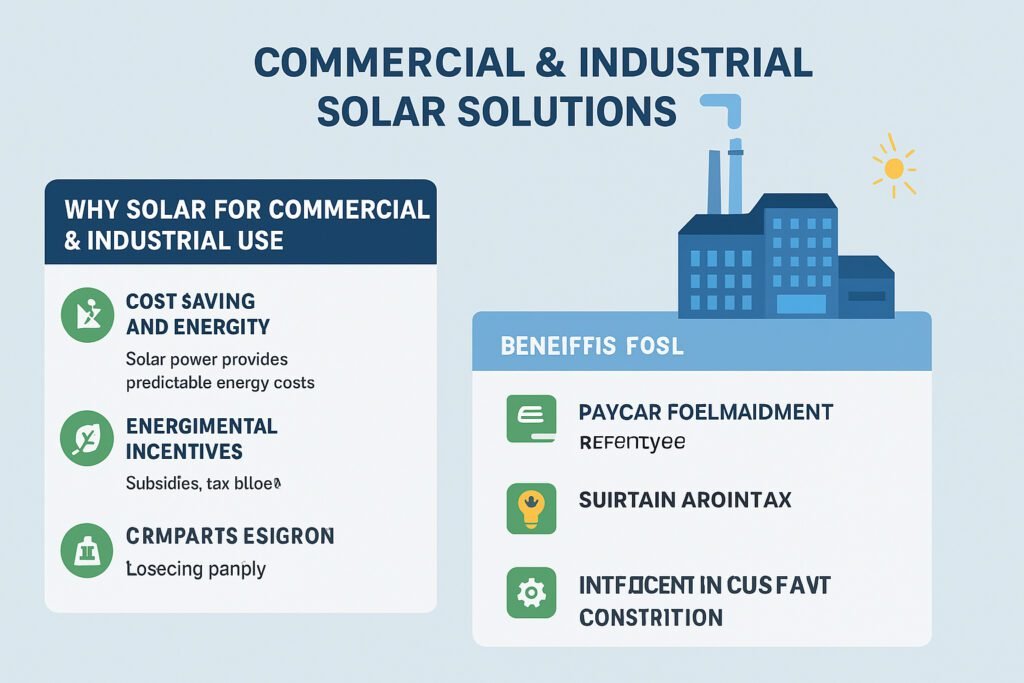The global transition to clean energy is reshaping the way businesses operate. For commercial and industrial (C&I) sectors, solar power has emerged as one of the most viable and impactful solutions to meet growing energy demands sustainably. With rising electricity costs, increasing regulatory pressure to cut carbon emissions, and the need for energy independence, organizations are rapidly adopting solar energy systems. In India and across the world, C&I solar solutions are now a critical component in achieving energy security, financial savings, and corporate sustainability goals.
Why Solar for Commercial & Industrial Sectors?
Unlike residential or small-scale systems, C&I solar projects are designed for large energy consumption and operational efficiency. Industries, IT parks, shopping complexes, hospitals, and educational institutions consume significant electricity daily, often leading to high operational expenses. Solar offers:
-
Cost Savings: Once installed, solar systems provide electricity at a fraction of grid costs, reducing monthly bills.
-
Energy Independence: Businesses can generate their own power, reducing dependence on volatile grid supply.
-
Sustainability: Solar adoption helps organizations align with global ESG (Environmental, Social, and Governance) standards and reduce carbon footprints.
Key Types of C&I Solar Solutions
1. Rooftop Solar Systems
Many factories, warehouses, and corporate offices have large rooftops, making them ideal for solar panel installations. Rooftop systems utilize otherwise unused space, offering decentralized power generation without disrupting operations.
2. Ground-Mounted Solar Systems
When rooftop space is insufficient, businesses opt for ground-mounted solar farms near their facilities. These projects generate large-scale energy and can be integrated with grid supply for reliable performance.
3. Solar Carports
An innovative solution for commercial premises, solar carports provide shade and protection for vehicles while simultaneously generating electricity. Malls, IT parks, and airports are increasingly deploying solar carports.
4. Hybrid Solar + Storage Solutions
To overcome intermittency and ensure round-the-clock energy supply, many businesses are combining solar with battery storage. This ensures uninterrupted power even during grid outages, a crucial advantage for industries requiring 24/7 operations.
Benefits of Commercial & Industrial Solar
-
Reduced Operating Costs
With rising grid tariffs, solar offers businesses long-term stability in energy expenses. In some cases, companies have reported savings of up to 30–50% on electricity bills. -
Attractive Return on Investment (ROI)
Initial capital expenditure on solar systems is offset within 3–5 years, while the lifespan of panels extends up to 25 years, ensuring decades of free power. -
Government Incentives & Policies
In India, initiatives such as accelerated depreciation benefits, net metering, and exemptions in transmission charges encourage businesses to go solar. -
Green Branding & CSR
Consumers and investors increasingly prefer sustainable businesses. By adopting solar, organizations not only save money but also enhance their brand value as eco-conscious entities. -
Energy Reliability & Risk Management
Frequent power cuts and fluctuating tariffs disrupt industrial productivity. Solar solutions, especially when paired with storage, reduce such risks and ensure reliable operations.
India’s C&I Solar Market Outlook
India’s C&I solar market is growing rapidly due to supportive policies and cost reductions in solar technology. According to industry reports, the C&I segment accounts for nearly 30–35% of India’s total solar capacity additions. The growth is driven by:
-
Declining solar panel costs.
-
Rising electricity tariffs for industrial and commercial consumers.
-
Increasing awareness of renewable energy benefits.
-
Pressure on corporations to meet net-zero and sustainability goals.
Leading sectors adopting solar include manufacturing, textiles, IT services, real estate, healthcare, and education.
Challenges in Adoption
Despite rapid growth, some challenges persist:
-
High Initial Capital: Although ROI is attractive, upfront investment can be a hurdle for small and medium enterprises (SMEs).
-
Policy Uncertainty: Changes in net metering regulations or subsidy policies sometimes create confusion among investors.
-
Space Constraints: Not all businesses have adequate rooftops or land for installation.
-
Intermittency: Solar generation depends on weather conditions, though hybrid and storage solutions are addressing this.
The Way Forward
With advancements in solar technology, falling battery costs, and improved financing options, C&I solar adoption is set to accelerate further. Emerging models like solar-as-a-service, leasing agreements, and green power purchase agreements (PPAs) are making it easier for businesses to shift to clean energy without heavy upfront costs.
Moreover, as India pushes toward its 500 GW renewable energy target by 2030, the C&I segment will play a pivotal role in driving this transformation.

